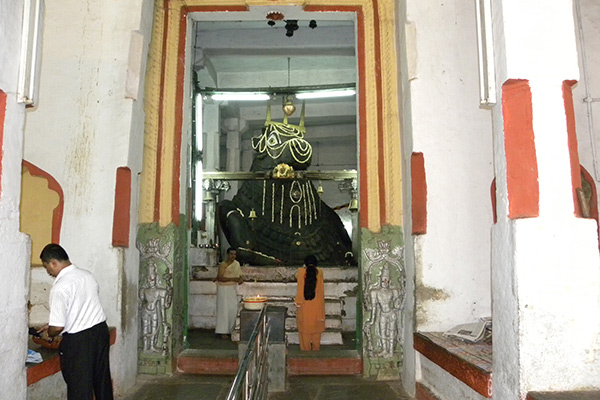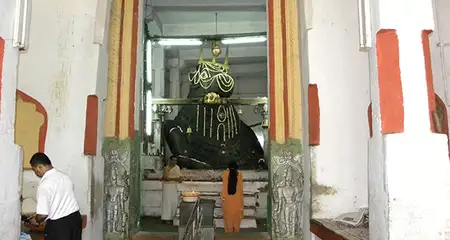The Bull Temple, also called by other names such as Nandi Temple and Dodda Basavana Gudi, is among the most remarkable and oldest temples in Bangalore. As the name suggests, it is dedicated to Nandi, the sacred bull who is revered as a Hindu Demi-God and the vehicle or mount of Lord Shiva. The key attraction here is a colossal statue of Nandi carved out of a granite monolith. As a religious site that draws devotees and tourists alike, this 16th-century temple deserves a place in your Bangalore itinerary.
Here is everything you need to know about the Bull Temple in Bangalore, including its history, architecture, timings, entry fee, attractions, and other interesting and lesser-known facts.
Bull Temple, Bangalore Information
| Location | Bull Temple Road, Basavanagudi |
| Also Known as | Dodda Basavana Gudi, Big Bull Temple, and Nandi Temple |
| Type | Hindu Temple |
| Distance from Major Transportation Hubs | KSR Bangalore City Railway Station (5 km); Cantonment Railway Station (10 km); Yeshwantpur Junction (11 km); Kempegowda International Airport (39 km) |
| Dedicated to | Nandi, Lord Shiva’s Bull |
| Timings | 6:00 am to 12:00 noon and 5:30 pm to 9:00 pm; every day |
| Photography and Videography | Allowed |
| Entry Fee | Free |
| Constructed in | 1537 |
| Constructed by | Kempe Gowda I |
| Architectural Style | Vijayanagara style |
| Material Used for the Statue | Granite |
| Dimensions of the Statue | 15 feet (height) and 21 feet (length) |
| Attractions | The colossal Nandi Idol, the Bugle Rock Park with a 3000-million-year-old rock formation, and the nearby Dodda Ganesha Temple |
| Festivals | Kadalekai Parishe or the Groundnut Fair |
| Nearest Bus Stop | Bull Temple (280 meters by walk) |
| Nearest Metro Station | Lalbagh (2 km) and National College (2 km) on the Green Line |
Bull Temple, Bangalore: History
Counted among the oldest and must-visit temples in Bangalore, the Bull Temple traces its origins back to the times of the Vijayanagara Empire. It was constructed in 1537 by Nadaprabhu Hiriya Kempe Gowda aka Kempe Gowda I, the founder of Bangalore city. As the temple is dedicated exclusively for the worship of Nandi, it came to be known by names such as the Bull Temple and Nandi Temple. The Kannada word for bull is basava, so the temple also goes by the local name Dodda Basavana Gudi which literally means the Big Bull Temple.
Bull Temple, Bangalore: Architecture
Built during the reign of the Kempe Gowdas, the temple exhibits the Vijayanagara style of architecture. In comparison to the colossal Nandi statue, the temple is a small structure. It has only one shrine with a porch attached to it, which is a characteristic feature of many temples built in this architectural style. The present tower of the temple is a fairly recent addition to the structure. It was constructed in the early part of the 20th-century and features motifs related to Shaivism.
The major attraction here is the Nandi statue which is considered to be one of the biggest of its kind in the whole world. The idol, which is made out of a single rock of granite, is about 20 feet long and 15 feet high. It is placed on a plinth and also has a Shiva Lingam placed beside it. In addition to these, the temple has idols of the Sun God (Surya) and Moon God (Chandra).
Bull Temple, Bangalore: Today
Today, the Bull Temple is a top attraction for all kinds of travelers and one of the must-visit temples in India. It is located inside the Bugle Rock Park, a lush green garden that houses a massive rock formation. Another age-old and famous temple in the city, namely Dodda Ganesha Temple aka Dodda Ganapati Temple, is also housed within the same park, right next to the Bull Temple. While the temple witnesses a massive footfall all year long, the number of visitors increases tremendously during the annual Groundnut Fair and Ugadi festival.
Kadalekai Parishe (Groundnut Fair) at Bull Temple, Bangalore
Kadalekai Parishe or the Groundnut Fair is an annual fair held on the last Monday and Tuesday of the Kartik month (October-November). During the fair, farmers from across Karnataka and the neighboring states offer their first produce of groundnut to Nandi and seek his blessings. They then proceed to sell their produce at the two-day fair.
People throng the temple in large numbers to buy a wide range of crunchy groundnuts including spiced, boiled, salted, fried, sugar-coated, and honey-roasted varieties. You will also find numerous stalls selling all kinds of items including toys, street food, clay-made idols, trinkets, and others. For those who want to soak in carnival-like vibes and relish some locally-produced groundnuts, this is the best time to visit Bangalore.
Things to See in the Bull Temple Complex, Bangalore
- The giant monolithic statue of Nandi, the Shiva Lingam placed behind it, and the idols of the Sun God and the Moon God in the temple.
- The Bugle Rock Park, a garden with centuries-old natural rock formations. It houses numerous trees, well-paved walking paths, and a water tank with murals of notable figures in Karnataka including Kempe Gowda, Mokshagundam Visvesvarayya, and D.V Gundappa. The thickly tree-lined garden is also home to large numbers of fruit bats.
- A massive rock, known as the Bugle Rock, assessed to be 3000 million years old. It is one of the major attractions at the Bugle Rock Park. The watchtower built on the rock offers beautiful views of the city.
- The Godda Ganesh Temple or Dodda Ganapati Temple, another major temple in the city, located right next to the Bull Temple. The shrine features an 18-feet high and 16 feet wide idol of Lord Ganesha.
Lesser-known Facts about Bull Temple, Bangalore
- The statue of Nandi at the temple was originally a grey structure. But over the years, it has turned black due to the regular application of coconut milk and butter by the devotees.
- As per an inscription found inside the Bull Temple, the Vrishabhavathi River flowing to the western part of Bangalore has its source in a spring located beneath the Nandi statue.
- Legends have it that the area where the temple is currently situated was once a vast groundnut field. When a wild bull started destroying the crops, farmers in the area came together to stop it and a fight ensued. During the fight, a farmer happened to hit the bull on its head with a stick and the bull instantly turned into a statue which kept growing with each passing day. The frightened farmers prayed to Lord Shiva who answered their prayers and stopped the statue from growing by placing a metal plate on its head.
Attractions near Bull Temple, Bangalore
- Sri Govardhana Temple (250 m)
- Gavi Gangadhareshwara Temple (1 km)
- Lalbagh Botanical Garden (2 km)
- Tipu Sultan’s Summer Palace (3 km)
- Bangalore Fort (3 km)
- Cubbon Park (4 km)
- Venkatappa Art Gallery (5 km)
- Visvesvaraya Industrial and Technological Museum (5 km)
- The Government Museum (5 km)
- Banashankari Temple (5.5 km)
- Attara Kacheri (6 km)
- Vidhan Soudha (6 km)
- Mark’s Cathedral (7 km)
- Ulsoor Lake (9 km)
- Bangalore Palace (9 km)
After spending some time at the temple and the Bugle Rock Park, head over to Vidyarthi Bhavan, one of the iconic restaurants in Bangalore. It is located about 700 meters from the temple, so you can end your trip by digging into their signature Masala Dosa and a cup of filter coffee.




























